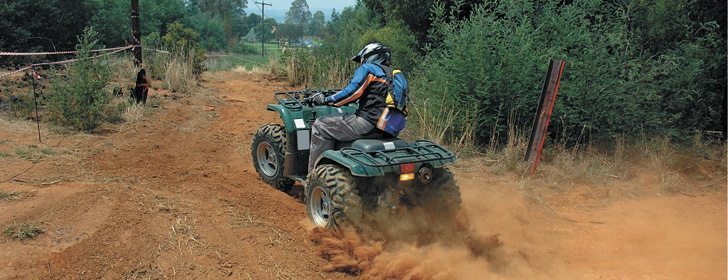All terrain vehicles have become as common in farmyards as half-ton trucks and tractors.
It’s so easy to jump on the seat and take off over a field to check on livestock or a watering system, or to haul supplies.
It’s also fun.
But their increased use for both work and play comes with a reminder to drive ATVs properly and safely.
According to the Canadian Agricultural Injury Surveillance Program, machine rollovers are the leading cause of death on Canadian farms and ranches. Between 1990 and 2004, rollovers killed 351 people.
Read Also

Mixed results on new African swine fever vaccine
The new African swine fever vaccine still has issues, but also gave researchers insight into how virus strain impacts protection against the deadly pig disease.
Twenty-five of those deaths involved off-road vehicles and in one-third of the cases the operator was under the age of 16.
Newscasts throughout the country carry other stories of recreational riding that has resulted in tragic consequences.
Driving an ATV requires skill, attention, strength and good judgment.
Young children usually don’t have those attributes, particularly when it comes to larger ATVs, and most organizations recommend children under age 12 not use ATVs at all.
The Canadian Pediatric Society says children under age 14 should not use them, while some organizations say children aged 12 to 16 can drive smaller vehicles with motors no more than 90 cubic centimetres as long as an adult is supervising.
Glen Blahey, provincial farm safety co-ordinator in Manitoba, said it is important that everyone who is going to be driving an ATV knows how it operates.
His office offers courses for farmers and ranchers, including practical sessions, on ATV driving.
“It shouldn’t be a learn-as-you-go process.”
He said most farmers and ranchers purchase ATVs with work in mind, not recreation.
“ATVs are primarily an extension of the farm equipment,” he said.
They are seen as extra transportation and a replacement for the horse when checking cattle. Taking a few hours to learn how to properly drive an ATV or making sure that farm workers know how to operate it is key.
“We need farm families to be a little more conscious of stopping and assessing the needs of who is going to be doing the work,” Blahey said. “You have to make sure the person has those skills.”
He said statistics show that new operators or new workers on farms are at greater risk of being injured because they don’t have a thorough understanding of how an ATV turns, for example.
Under Manitoba law, workers must be properly trained if they are required to drive an ATV for their jobs.
David Burnett, chief instructor for ATV safety courses in Saskatchewan, said most of the participants in his courses are people who need certification for their jobs.
For example, every energy industry worker needs to take the course.
“Half of the course is actual riding,” Burnett explained. “Turns, starting and stopping, going up and downhill.”
By the end of the course he notices quite a difference in the ability of the drivers to handle the machines.
He said few farmers take the course, and that concerns him.
“They don’t bother wearing the safety equipment either,” he said.
Saskatchewan legislation states that helmets are not mandatory when the ATV is operated on property owned by immediate family.
But Burnett said that shouldn’t preclude common sense.
And he also notes that the first time a rider crosses a road, he or she is on public property.
The All Terrain Vehicles Act and its regulations prescribe the type of approved helmets and eye protection that all riders or passengers must wear.
Owners and operators might also be surprised to know they must carry a minimum of $200,000 in liability insurance.
“Very few have insurance,” Burnett said. “A few more are starting to wear helmets.
“These laws are not new.”
Legislation sets out other parameters, including a maximum speed of 80 km/h and prohibiting driving on the traveled portion of a highway.
Burnett said the Saskatchewan law says that to drive in ditches or on crown land, the operator must have a valid driver’s licence. Children under age 16 who have taken the ATV course, however, can legally operate the machines by themselves.
Manitoba’s Off-Road Vehicles Act restricts children under age 14 from operating ATVs unless an adult or parent is supervising.
ATVs must be registered and insured, unless they are going to be used only on land owned or leased by the vehicle owner.
Helmets are required in Manitoba, except when the ATV is being used for farming, hunting, fishing or trapping. Passengers are not permitted, except when the ATV has a seat designed for a passenger.
The vehicles typically aren’t allowed on highways and other roadways, but there are exceptions. In Alberta, for example, ATVs can be on the highway as long as the operator has a licence.
Alberta’s regulations state that the minimum age for operating an ATV is 14. Younger children can drive them on public property if they are being supervised. There is no age restriction on private property.
Helmets are not mandatory in Alberta unless municipal bylaws require them. However, legislators do recommend their use.
In all jurisdictions, three-wheeled bikes are not recommended.
They haven’t been manufactured or sold in North America since the 1980s because of their tendency to roll over and cause serious accidents.
However, there are still some of these models in use, particularly by children on farms. Farmers are urged to replace these models with safer, four-wheeled ATVs.
Burnett said he also sees children operating ATVs that are much too large for them. Passengers can also be a problem.
According to the ATV Safety Manual for Agricultural Workers issued in Manitoba, the driver must be able to move freely on the ATV in order to control it. A passenger interferes with that ability.
“A passenger raises the ATV centre of gravity to a dangerous level,” says the manual.
This happens because a passenger adds instability to either the front or rear axle.
A passenger can also be in the way if the driver needs to get off quickly.
Farmers who want to take a safety course or need more information about ATV safety should contact their provincial farm safety co-ordinators or ATV riding associations.
Burnett can co-ordinate safety courses around Saskatchewan. He can be reached at burnett3@sasktel.net.
















